Phone:
TBA
Physical address:
TBA
Scaffolding and Weather Conditions – When dealing with scaffolding, weather conditions impact safety and stability. High winds can loosen ties and turn tools into projectiles, while rain creates slippery surfaces and weakens the structure. Snow adds weight and makes surfaces slick, so regular snow removal and anti-slip materials are essential. Extreme heat can expand metal, while cold makes it brittle. Always use weather-resistant materials, secure anchoring, and perform regular inspections. Training your team on weather-related hazards and ensuring they’re equipped with proper gear is crucial. Continue further to find best practices and detailed safety measures.
Wind’s impact on scaffolding can’t be underestimated, as strong gusts pose serious safety risks. When you’re working on scaffolding, even moderate winds can affect stability, making the structure sway or even collapse, so always check the weather forecast. It’s crucial to be aware of how wind can compromise both the scaffolding and the safety of those working on and around it, especially during extreme weather events.

Firstly, high winds can loosen ties and anchors that secure scaffolding to a building. If these critical components aren’t tight, the entire structure can become unstable. You should always double-check their integrity, especially after a windy day. Additionally, materials and tools left on the scaffolding can become dangerous projectiles in strong winds, posing risks not just to workers but also to pedestrians below. Secure all loose items to minimize this hazard.
Moreover, scaffolding itself can act like a sail, catching the wind and amplifying its force, a concern that should be monitored through regular weather forecasts. This is particularly problematic with larger, taller structures, which are more susceptible to the impacts of stormy weather. It’s advisable to use windbreaks or netting to help reduce wind impact, though these should be properly installed to avoid creating additional risks.
When it rains, you need to be extra cautious about slippery surfaces on the scaffolding, which can lead to dangerous falls. Additionally, water can compromise the structural integrity of the scaffolding, making it less stable. Always inspect the equipment and take necessary precautions to ensure safety during wet conditions.
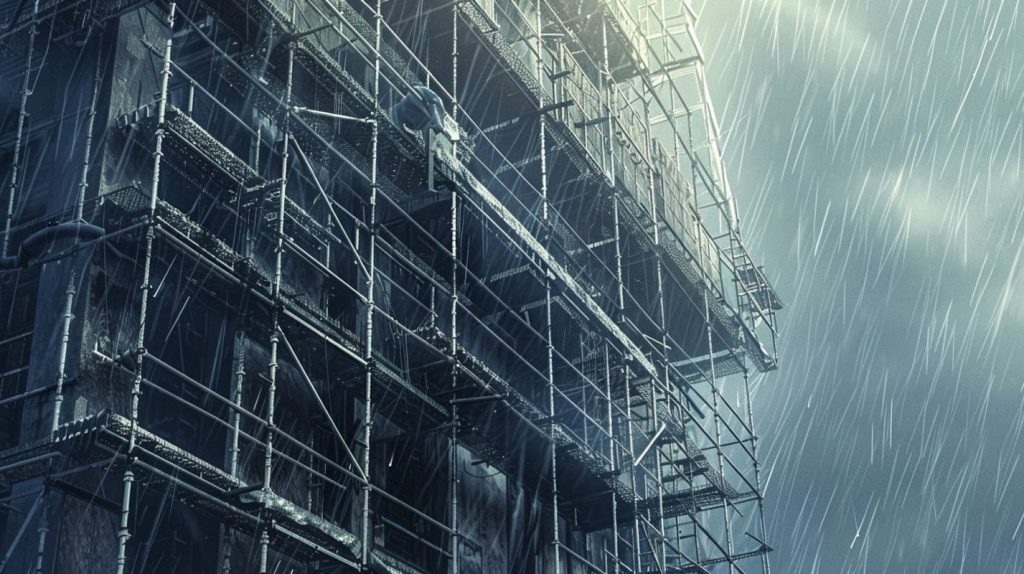
Rain can create treacherously slippery surfaces on scaffolding, increasing the risk of accidents. Imagine you’re high up on scaffolding, and a sudden downpour leaves the planks slick and hazardous. Your footing becomes uncertain, and even the smallest misstep can lead to a dangerous fall, especially during extreme weather events. It’s critical to recognize these risks and take immediate action to mitigate them.
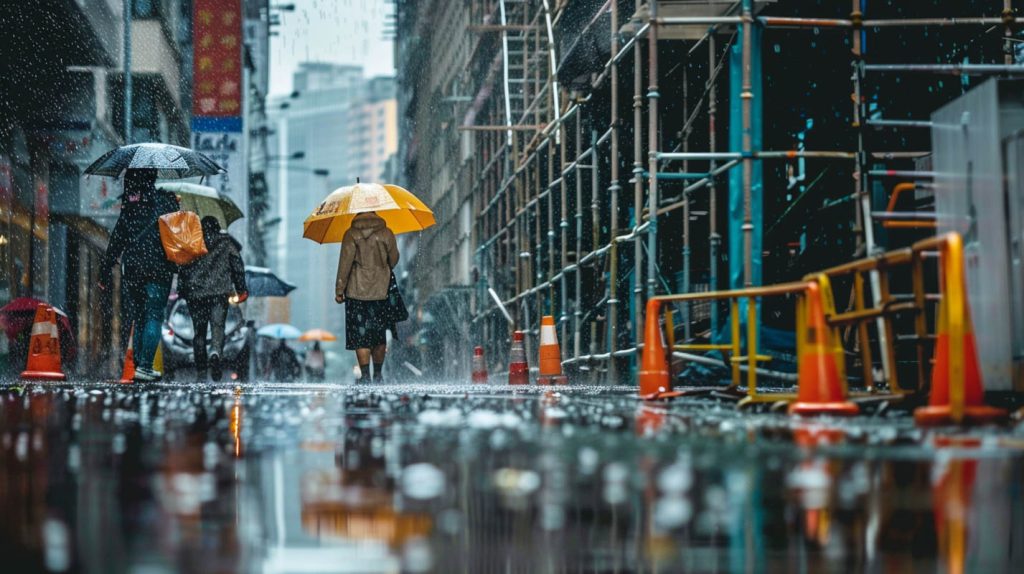
First, always wear non-slip footwear. It’s one of the simplest yet most effective ways to improve your grip on wet surfaces. Additionally, you should inspect the scaffolding regularly to ensure there’s no buildup of water or mud, which can make conditions even worse. If rain is expected, consider using safety harnesses and guardrails to provide extra security.
Another important step is to communicate with your team about any changes in the weather forecast. Make sure everyone is aware of the slippery conditions and emphasize the importance of moving cautiously, particularly in response to the latest weather forecast. If possible, postpone tasks that require intricate movements or heavy lifting until the scaffolding is dry, particularly during stormy weather. Lastly, consider using temporary coverings or tarps to shield the work area from rain. Taking these precautions can significantly reduce the likelihood of slips and falls, keeping you and your team safe.
Beyond the immediate risk of slips, rain poses serious threats to the structural integrity of scaffolding. When it rains, water can seep into joints and connections, causing wood to swell and metal to rust, which can be exacerbated by different weather conditions. This can weaken the scaffolding structure, making it less stable and more prone to collapse. If you’re not vigilant, the integrity of your scaffolding can deteriorate rapidly.
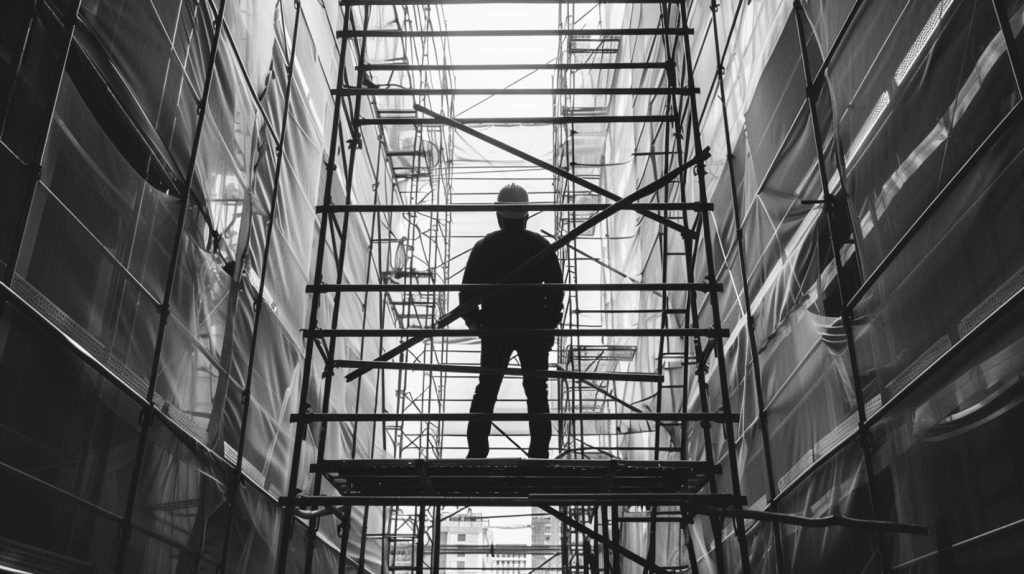
You’ve got to pay close attention to how water accumulates on different parts of the scaffolding. Pooled water can add extra weight, stressing the structure beyond its intended load capacity. Moreover, if water freezes, it can expand and cause further damage. You should ensure proper drainage systems are in place to prevent water from collecting.
Regular inspections become even more critical during rainy conditions. Check for any signs of rust, swelling, or other damage after each rainstorm. Use weather-resistant materials wherever possible to add an extra layer of protection. If you discover any compromised sections, don’t hesitate to replace them immediately. Your vigilance plays a key role in maintaining a safe work environment. Remember, it’s not just about avoiding slips; it’s about ensuring the entire scaffolding structure remains sound and secure.
Snow and ice can significantly impact the safety and stability of scaffolding structures. As winter sets in, these elements can accumulate on scaffolding, adding unwanted weight and causing slippery conditions. If you’re working on scaffolding in snowy or icy weather, you need to be extra cautious. The additional weight from snow can stress the scaffolding beyond its designed limits, potentially leading to structural failure. Regularly clear the snow to prevent dangerous overloads.
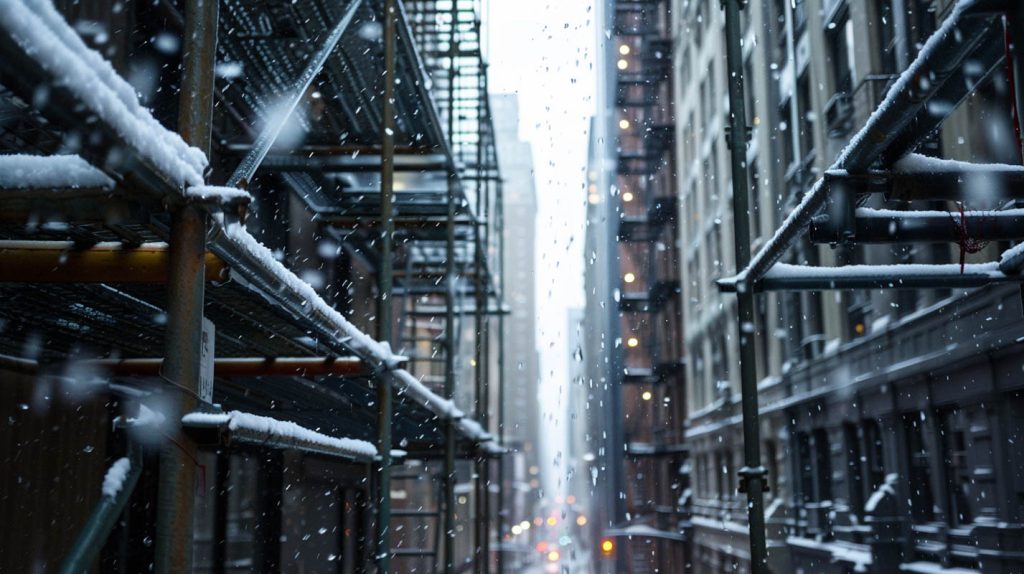
When it comes to ice, it’s not just about the added weight. Ice can form on surfaces, making them incredibly slippery. This poses a serious risk of falls for anyone working on the scaffolding. Make sure to use anti-slip materials and consider applying salt or other de-icing agents to the walkways and platforms. Safety harnesses and other personal protective equipment (PPE) become even more critical in these conditions.
Inspect the scaffolding frequently during winter months. Look out for any signs of damage or stress caused by snow and ice build-up. Connections and joints can become compromised, so ensure they’re secure and in good working condition. It’s also wise to avoid working on scaffolding during severe weather conditions. If it’s snowing heavily or ice is forming quickly, postpone the work until conditions improve.
Communication is key in these scenarios. Keep everyone informed about the weather conditions and any potential hazards. Regular safety briefings can help ensure that everyone knows the risks and the necessary precautions. Snow and ice might be a part of winter, but with the right measures, you can mitigate their impact on scaffolding safety.
While snow and ice present clear challenges, extreme temperatures can also wreak havoc on scaffolding safety and integrity. When temperatures soar, metal scaffolding can expand, potentially altering its structural alignment, a factor that should be considered in the weather forecast. This can lead to unexpected weaknesses or even the failure of joints and connections. High temperatures can also make surfaces hot to the touch, posing burn risks to workers. Additionally, extreme heat can affect the performance of any protective coatings or materials used on the scaffolding, leading to quicker degradation and the need for more frequent inspections, especially during extreme weather events.
On the flip side, frigid temperatures have their own set of challenges. Metal becomes brittle in the cold, increasing the likelihood of cracks or breaks under stress, making it essential to consult the weather forecast before starting work. Any moisture that seeps into joints can freeze, expanding and causing further damage. Cold weather also impacts the flexibility and strength of materials like wood and plastic, which might be parts of the scaffolding system. Workers themselves face increased risks of hypothermia and frostbite, which can make them less attentive and more prone to accidents.
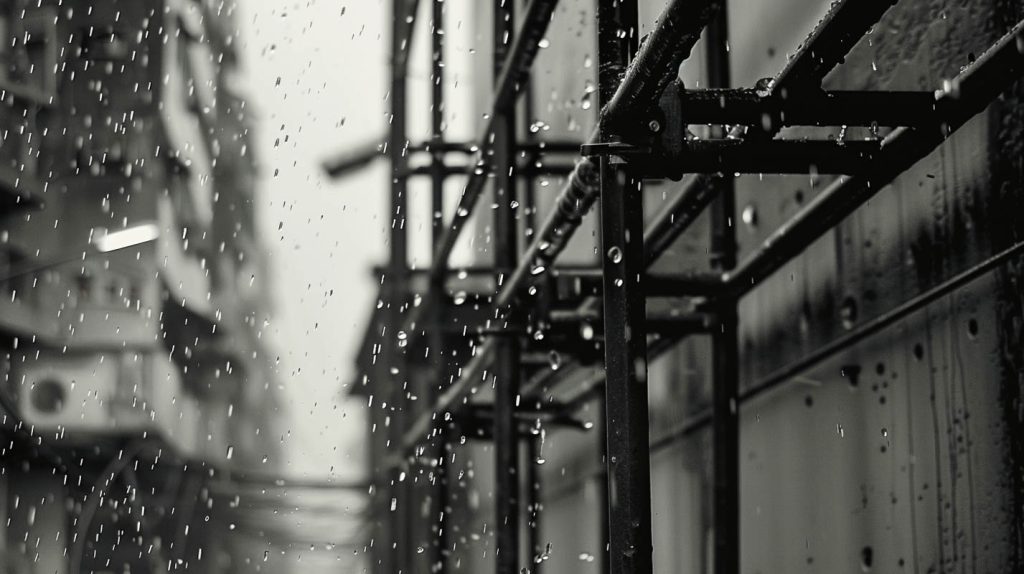
Temperature extremes can also affect the stability of the ground where scaffolding is erected. In extreme heat, soil can become dry and loose, making it less stable. In freezing conditions, the ground can become uneven as it freezes and thaws, potentially compromising the scaffolding’s foundation.
Being aware of these issues is crucial for maintaining a safe working environment. It’s essential to monitor temperature conditions and understand how they can impact both the scaffolding and the workers using it. Ignoring these factors can lead to dangerous situations that compromise everyone’s safety.
To ensure scaffolding safety in varying weather conditions, it’s crucial to adopt best practices that address the specific challenges posed by temperature extremes, moisture, and ground stability. First, always start by conducting a thorough site assessment to understand how different weather conditions might impact the construction site. Look for any potential hazards related to the weather, such as icy surfaces, waterlogged ground, or areas prone to high winds. This step helps you plan the scaffolding setup more effectively.
Next, ensure that the scaffolding materials are suitable for the weather conditions. For example, opt for galvanized steel or aluminum, which can withstand rust and corrosion better than other materials. If you’re working in extremely cold temperatures, be mindful of the brittleness that can affect some materials and adjust your selections accordingly. Go back to Scaffold for Hire Home Page.
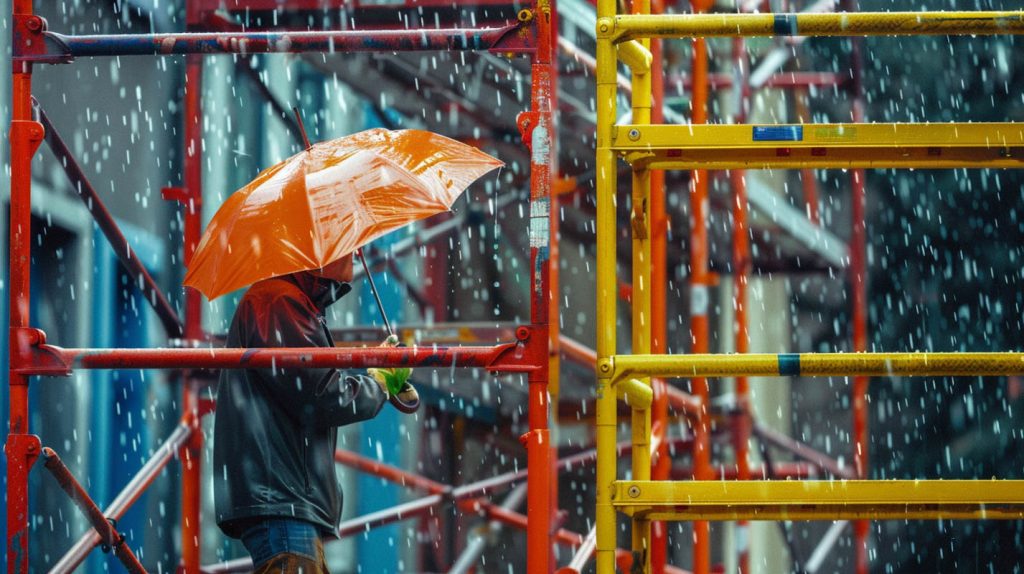
Anchoring the scaffolding securely is another critical step. In windy conditions, use additional tie-ins and braces to stabilize the structure. Always check that the ground is firm and level before erecting the scaffolding, as different weather conditions can weaken the ground. If the ground is soft or uneven, consider using mud sills or base plates to distribute the weight more evenly.
Regular inspections are key. Perform daily checks to ensure all components are secure, especially after any significant weather changes. Look for any signs of wear and tear that could be exacerbated by the weather, such as cracks or rust.
Lastly, train your team thoroughly. Make sure everyone is aware of the potential weather-related hazards and knows how to react appropriately. Equip them with the necessary safety gear, like non-slip footwear and weather-appropriate clothing, especially during extreme weather events. By following these best practices, you can significantly mitigate the risks associated with scaffolding in various weather conditions.
Adhering to safety regulations is essential for minimizing the risks associated with scaffolding work in various weather conditions. You need to follow these guidelines to ensure not only your safety but also the safety of everyone on the site. Regulations often address issues such as proper scaffolding assembly, weight limits, and the use of personal protective equipment (PPE). However, weather conditions add another layer of complexity that you must consider.
When working in windy conditions, securing all scaffolding components is a must to prevent potential collapse. High winds can destabilize structures, making it crucial to double-check all fastenings.
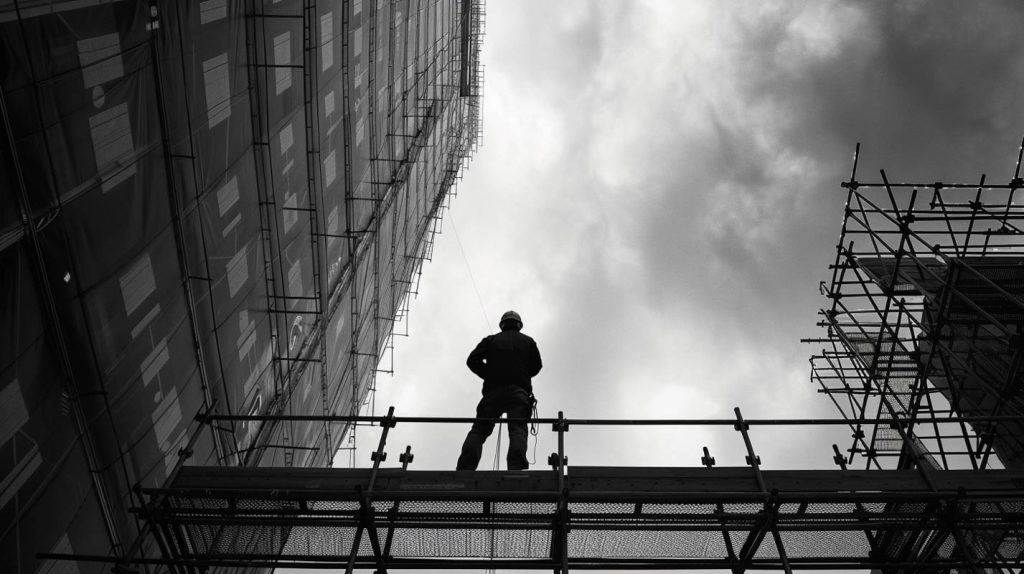
Snow and ice can add significant weight to scaffolding, risking structural failure. It’s important to clear any accumulation and verify that the scaffolding can handle the load before starting work.
Rain makes surfaces slippery, increasing the risk of falls. Always use non-slip boots and rain gear to maintain footing.
Lastly, regardless of weather conditions, daily inspections are non-negotiable. Check for any signs of instability or wear and tear. This ensures the scaffolding remains safe for use throughout the day.
You’ve got to consider material choice for scaffolding stability. Steel’s strong but heavy, aluminum’s lighter but less rigid, and wood’s cost-effective but can weaken over time. Each material impacts the overall safety and performance.
You’ll notice common signs of scaffold wear and tear like rust, loose bolts, cracked welds, and bent frames. Regularly check for these issues to ensure safety and avoid potential hazards during your projects.
Yes, scaffolding can be safely erected on uneven terrain, but you’ll need to use adjustable base plates and leveling jacks. Ensuring a stable foundation is crucial, so don’t skip these essential steps for safety.
You should inspect scaffolding for safety compliance before each use, after any incident, and periodically during long-term projects. Regular checks ensure it’s stable and safe, protecting everyone involved in the construction process.
You’ll need essential tools like a level, wrench, hammer, pliers, safety harness, and tape measure for scaffolding assembly. Don’t forget sturdy gloves and hard hats to ensure everyone’s safety during the construction process.